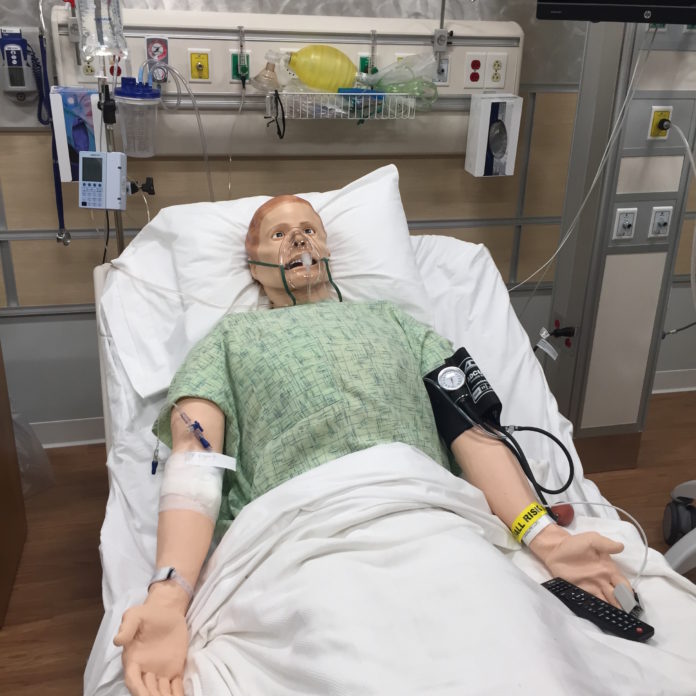
LINCOLN – Why were people surprised to hear an infant’s cries and an adult’s complaints at the Community College of Rhode Island’s Flanagan Campus in Lincoln on the afternoon of Dec. 1? Humans’ cries and complaints are nothing extraordinary, but these came from high-tech manikins, which serve as the “patients” at CCRI’s new Clinical Simulation Laboratory that offers allied health students an array of realistic simulation experiences.
“These manikins can do everything a human body can do – they can simulate labor and delivery; they can excrete, urinate … and change color to [appear ill],” said Daniel Connor Jr., a second-year nursing student who expects to study for his bachelor’s degree in nursing at the University of Rhode Island, after graduating from CCRI in May 2017. “I have done three simulations in the new lab, and it’s very impressive. The difference between the [old lab and this one] is unbelievable; [this one is] like a Miriam Hospital room.”
With no faculty supervision or guidance, a four-person student team (nursing, dental hygiene, respiratory care or emergency medical services’ students) enter the simulation bay to treat a “patient,” whose problem might be a head trauma, breathing problems, postpartum hemorrhaging or diabetes, for example. The lab’s two simulation bays are designed to look exactly like state-of-the-art hospital rooms, with all the attendant equipment as well as audiovisual equipment that records and livestreams the simulation events into the debriefing rooms. While one team is treating a patient, another team watches the livestream of the team’s interactions with and treatment of their “patient” in a debriefing room. That’s active learning; one hour in the lab is equivalent to two hours of clinical experience, said Lisa Burke, CCRI coordinator of clinical nursing education. “What goes on in the sim room stays in the sim room; it’s a safe learning experience.”
CCRI President Meghan Hughes’ description of these simulations as “frighteningly realistic” drew appreciative laughter. CCRI, New England’s largest community college, graduated almost 500 students in health care last year, she said, noting CCRI’s responsibility to prepare its students to be the highest caliber, well-trained graduates who are ready to enter the health care workforce and, for some, to eventually transfer into a four-year institution. She expressed pride that CCRI is the largest supplier of health care workers in the state.
This advancing technology augments clinical opportunities, said Burke. CCRI nursing students assigned to a local hospital’s maternity rotation may never witness a woman giving birth, but here, they observe labor and delivery. Asked how the manikins respond and react, Burke said, “Our technicians [in the lab’s control room, which has a two-way mirror to the simulated hospital bay] guide the experience; they are the tour guides.” These technicians – one with nursing experience and one with EMT experience – can bring a manikin to life or death; they program each manikin for a particular scenario and the manikin responds to students’ responses, said Burke. Students also learn bedside manner techniques of talking with and asking questions of patients. The students’ reactions to these experiences have been, said Burke, “mind-blowing. If they do a wrong intervention, they will see that the manikin is having trouble breathing, for example. They have to interact with each other and the manikin.”
CCRI contributed $675,000 for the infrastructure of the project, which had its soft opening in October. The Champlin Foundations donated $324,000 for technology, software and the manikins, said Patrick Stone, CCRI’s director of marketing, communications and publications. Laerdal, a leading vendor of medical simulation and clinical education equipment, makes the manikins. CCRI currently has two high-fidelity SimNewB neonatal simulators, two SimJunior pediatric simulators, two SimMom obstetrical simulators and two 3G adult simulators.
Both Hughes and Burke see opportunities for other students to use the Clinical Simulation Laboratory. Students studying law enforcement, for example, could respond to a simulated mass shooting. Art students may practice moulage – the art of applying mock injuries to a body for training purposes – and theater students could portray a patient’s relatives who might be hostile, supportive or dismissive.
Dr. Nicole Alexander-Scott, director of the Rhode Island Department of Health, was a “stand-in” for Gov. Gina M. Raimondo at the ceremony, where other CCRI representatives also spoke. “I can appreciate … the benefits of simulation and how it can tremendously impact our medical training,” she said. “I can remember getting certified in advanced cardiac life support and … being grateful that I was having actual learning experiences with manikins.”
Pleased that CCRI’s new lab will contribute to enhancing students’ ability to acquire the “skills that matter for the jobs that pay,” Alexander-Scott echoed Raimondo’s belief: “A healthy thriving economy is what underlies a healthy thriving Rhode Island.”














